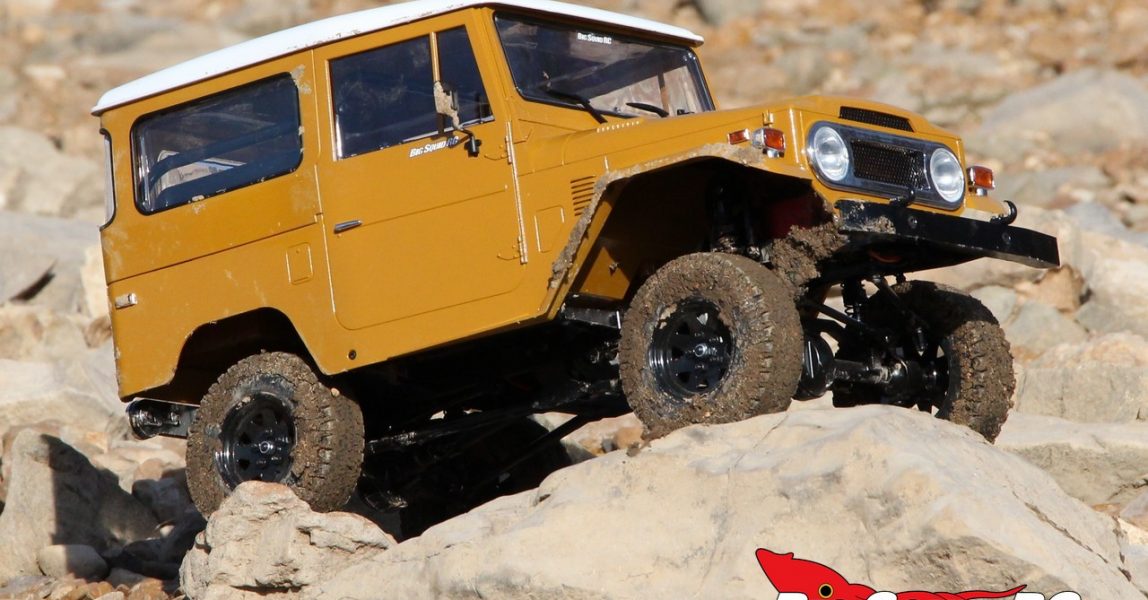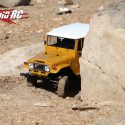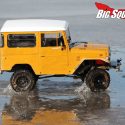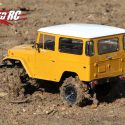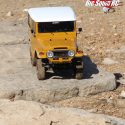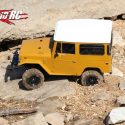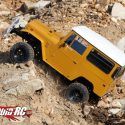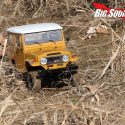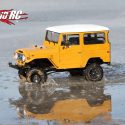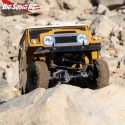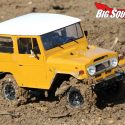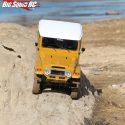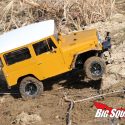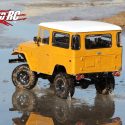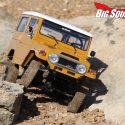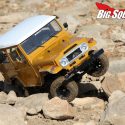The scale crawling scene is blazing hot right now, to help feed the fire RC4WD is releasing a RTR version of the Gelande II with a Cruiser Body Set. We have been lucky enough to receive an early release unit to bash at our pleasure. Actually, we haven’t been “bashing” it as much as we’ve been using it for what it was intended for- rock crawling and trail driving. We’ve got a few weeks of driving in with the Cruiser and have finally wrapped up our review. Read below to find out our thoughts on the RC4WD and to see if it is worthy of finding a place in your rc garage.
From: RC4WD
Direct Link: Gelande II Cruiser RTR
Unboxing Pictures: BSRC Unboxes The Cruiser RTR
Review By: Cubby
Photography By: Tim Mohr
Specs:
RTR or Kit: RTR
Age: 14+
2wd or 4wd: 4wd
Shaft or Belt: Shaft
Electric or Gas: Electric
Waterproof: Yes
Scale: 1/10th
Length: 18.35″
Width: 8.5″
Wheelbase: 10.83″
Weight: 8.02 lbs
Motor: RC4WD 45 turn brushed
Speed Controller: Outcry brushed, separate 6V 5 amp Turbo BEC
Radio: RC4WD XR3b 2.4GHz, 3 channel
Differential: Locked
Slipper Clutch: Yes
Driveshafts: Steel universals & plastic shafts
Final Drive Ratio: 31.9:1
Shocks: RC4WD dual spring
Servo Saver: None
Bearings: Yes
Screws: Metric, hex
Spur/Pinion Pitch: 32 pitch
Tires: RC4WD Dirt Grabber
Battery: Not included
Part Number: #Z-RTR0029
Warranty: “… are warranted to be free of defects in the materials and workmanship when new.”
Bashing Specs:
Front wheel travel (straight vertical): 0.8″
Rear wheel travel (straight vertical): 0.8″
Wheelie on demand: No, but possible when going from full reverse to full forward
Backflip off ramps: No
Stability Control: No
Sound Module: No
Self-Righting: No
FPV: No
Top Speed (measured by BSRC on 2S LiPo): 6 mph
Runtime (measured by BSRC): Even we aren’t crazy enough to measure runtime on a crawler.
Street Price: $529
Primary Competition: Other scale realistic crawlers like those from Vaterra and Axial.
What’s Needed To Complete: You won’t need a lot of extra gear to get the RC4WD on the trail. What you will need is a 2S LiPo battery, a charger, and four AA cells for the transmitter.
Build Quality: Our Bash Crew guys gave the truck a very close inspection when it arrived and could find no faults with its assembly. Gear mesh was spot on, the shocks were well built and not leaking, and we could find no binding in the drivetrain.
Test Drivers: Iron Mikeee, Hawaiian Chris, Robbie G., T-Money, and yours truly.
Test Venues: Nope, for the first time in forever, this one didn’t make it to the track. It didn’t make it to our local Costco either. However, we did hit over a half dozen different parks with it.
Set-up Notes: Bone stock buddy. We didn’t change a thing, but we did use a 2S MaxAmps LiPo for juice and a Hitec X1 Pro was used to handle the charging duties. Oh ya, we also used Duratrax AA cells in the transmitter.
Turning: Well, the truck does have locked diffs, so how would you expect it to turn? No, the Cruiser will not impress you for turning on pavement, dirt, or grass. However, it did a good job of turning when in its element- mud, sand, and in rocky sections. The Cruiser does have a high center of gravity, just like the 1:1 version does, but it doesn’t typically traction roll on pavement or on dirt. The stock tires and the truck’s general geometry did do a fine job of picking lines out on the trail, not fantastic like a modded truck, but quite well for a scale RTR.
Jumping: Ya know, we have jumped RC4WD scale trucks before, and no, you don’t want to. The Cruiser was never designed for big air so we didn’t go epic with our test unit, but we did jump it off of curbs and a park bench about 2 feet off the ground. It doesn’t have the RPM to make mid-air changes and the suspension is set-up for picking lines over rocks, not absorbing jump landings. If jumping is your thing, you will want to look elsewhere.
Bumps/Whoops: The Cruiser just doesn’t generate enough speed to “pound the whoops”. We did however drive slowly over all sorts of rough areas where the stock suspension worked fine but could have used a bit more articulation.
On-Road: Yes, of course we drove the Cruiser on pavement even though that is about as far away from its natural element as you’ll find. It has a low top speed and tends to push like a freight train, but then we doubt you’ll be doing much pavement time with yours.
Grass: Oh yes, good old grass. With its abundant weight and decent tires, we found the Cruiser could chew through taller grass than we expected. Heck, it was able to crawl through grassy areas with lots of tree roots and small saplings with little effort. We were very impressed.
Tires: While there are better tires on the market for pure grip on rocks or traction on loose soil, the stockers did a solid overall job. Looking like a true intermediate tire, the stockers were able to get over tougher rock sections than we expected and hooked up really well on harder packed soil. The biggest area they lacked in was loam/mud/sand, but overall we felt they were a good pick based on their looks and versatility.
Power: Ok, so half our test crew drives 6S monster trucks every day. So no, they weren’t impressed with the raw output power of the RC4WD, but this truck is not aimed at making 60 foot double jumps and purposely throwing tires off the bead. For what the truck was designed for, we rarely found it lacking for power. When crawling an intricate rock section or easing your way through a soft sand wash, a mild power delivery is essential and that’s what you get the stock 45 turn motor. The only time we wished for more raw power was when we got the truck jammed between rocks, this is when it could have used a few more watts to help get itself out of trouble. Thankfully those times were quite rare and we feel that it comes with enough power for 90% of what people will use it for.
Radio: We had no issues with the included transmitter. It isn’t fancy, but it gets the job done. The ergonomics felt fine and we liked the foam covered wheel. With the truck being a crawler we didn’t really test its range, but it had more than enough for how we used the truck. If there was one downside, it would be that the wheel is somewhat further from the grip than most other radios on the market, making it hard to drive one handed. Not that a lot of people drive that way, but it is becoming more common in today’s era with people always shooting pictures or video with a free hand.
Broken Parts: We didn’t break much on our test unit. The stock plastic driveshafts are still alive after our test, as is most of the truck. The outside rear view mirrors were the first items to go. They look awesome but didn’t live through our various crashes in cold temperatures (our average temp was around 35 F). Our test truck finally came to a halt after it lost some bolts in the front hubs, you might want to put some extra thread lock on yours.
Misc Notes:
We aren’t big fans of Tamiya connectors in general, but crawlers don’t pull a lot of current, thus the reason we left the Tamiya connector on our Cruiser.
The ESC allows you to go directly from forward, to reverse, to forward. This is great fun for popping wheelies (both forward and backwards!) but can also come in quite handy on the trail. Normally that type of ESC programming is not good from a durability standpoint, but for crawling it can help keep you out of a bind.
While our test unit had a bit of drag braking, it could have used a bit more out of the box.
While the Cruiser had a terrifically detailed body, we would have liked to have seen the wipers come down from the roof line and not up from the engine side for better realism.
When we first fired up our truck, the servo acted like it was DOA. That was not the case as we tracked it down to the servo wire not being firmly plugged into its wire extension that ran to the back of the truck for the receiver.
What is it really like with the Cruiser on the trail? That is perhaps the most important question of the review, so here ya go. The Cruiser does exactly what it was designed to do on the trail- give a scale realistic driving experience. Are you looking to get over 8″ tall vertical surfaces? That can be done with comp crawlers, but that isn’t going to happen with a scale oriented unit. The Cruiser does a great job of getting over what it could in real life. It can climb modest faces and side hill on lesser angles. The 1:1 real life Cruiser was never designed to win The King of the Hammers, it was designed to handle some modest off-roading and that’s exactly what the RC4WD model can do. The fun in the RC4WD is pushing the truck to the edge of its limits, then finding out exactly how steep you can make it go with perfect throttle control and wise line decisions. Because it can’t easily climb over everything in its path you have to think about angles, lines, and putting the tires exactly in the right spot. This leads to an experience that gives hour after hour of challenging fun.
There are a couple of different ways to take off the body. There are a pair of 2.0 bolts on each side, or you can remove four body clips that are completely hidden under the body. We typically just took out the bolts and really liked how there was no exposed body clips for more of a scale authentic appearance.
Best Mod Under: We were big fans with the truck right out of the box. However, every truck is more fun when modded and RC4WD has a LOT of mods already in stock for the G2 platform. So what would we do? We would bolt in a beefier Hitec servo and pick out some uber scale RC4WD tires that would be better suited to our particular driving venues.
Summary:
A = Outstanding/Best in Class, B = Above Average, C = Average, D = Below Average, F = Horrific
Time To Bash: B We found the RC4WD to be quick and easy to get running. Charge up a pack of your choice, pop four AA cells in the transmitter, then you are ready to start your off-road adventure.
Workability: B We had no issues working on the Cruiser. Granted, we didn’t have to work on it much, but when we did, everything was out in the open and easy to spin wrenches on.
Car Show Rating: A Here ya go folks, the new standard for scale realism in a ready to run rock crawler. The details on the Cruiser blew us away. The body is incredibly well done, the tire/wheel combo has the right type of look, and the truck simply keeps on delivering small scale details everywhere you look. It looks like a high-end static model that is actually rc capable. Also… the scale details don’t stop when you take the body, off, they just keep getting better. In a category where small details make all the difference, the competition has a long ways to go to catch up to this ready to run.
Bash-A-Bility: C Because of its weight and plastic body, you can’t bash it as hard as some of the other crawlers on the market. Still, our truck endured hours of hard trail driving and rock crawling with very few broken parts or issues.
Fun Factor: B Ok, so most of our test drivers are power fanatics, meaning they were looking for wheelie ripping power, but the RC4WD isn’t like that. The supplied power works well for crawling or trail driving and we had all sorts of fun getting a scale driving experience on various trails. Turning heads when back at the trail head was fun too.
Handling: B For a bone stock RTR scale crawler the Cruiser did an admirable job. Yes, it is top heavy, but then so is the 1:1 unit it was modeled after.
Value: A It is rare when we hold a truck in our hands and it just feels like it should cost $500. The RC4WD has a quality feel, uber looks, and is worth every penny in our opinion.
Parts Availability: C Now days it is easy to find G2 parts all over the web. We looked up a half dozen common replacement parts for the Cruiser and they were all readily available on the web. Also of note, we are seeing more local hobby shops stock RC4WD parts. To boil it down, you shouldn’t have any problems finding parts for the Cruiser when you need them.
BigSquid Rating: B We were totally blown away by the looks and general heft of the RC4WD RTR G2 Cruiser. It represents state-of-the-art in the ready to run scale crawling world, cut the check so you can experience what all the hype is about yourself.

